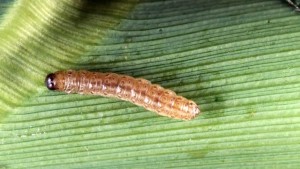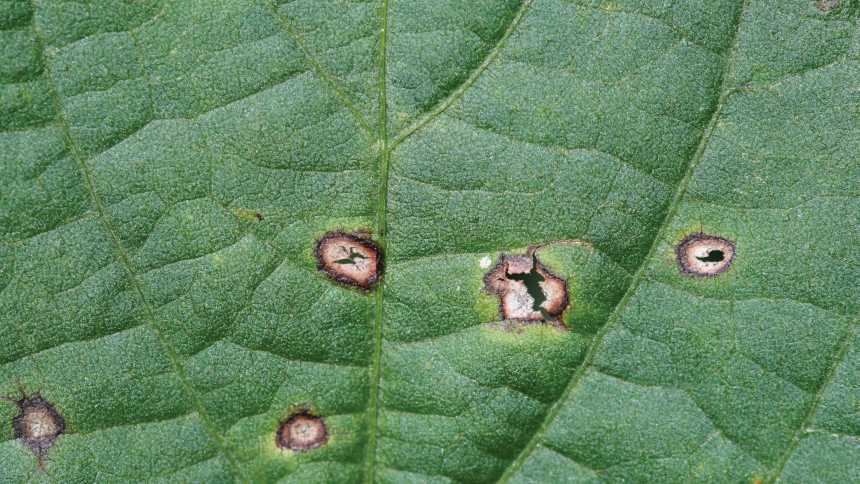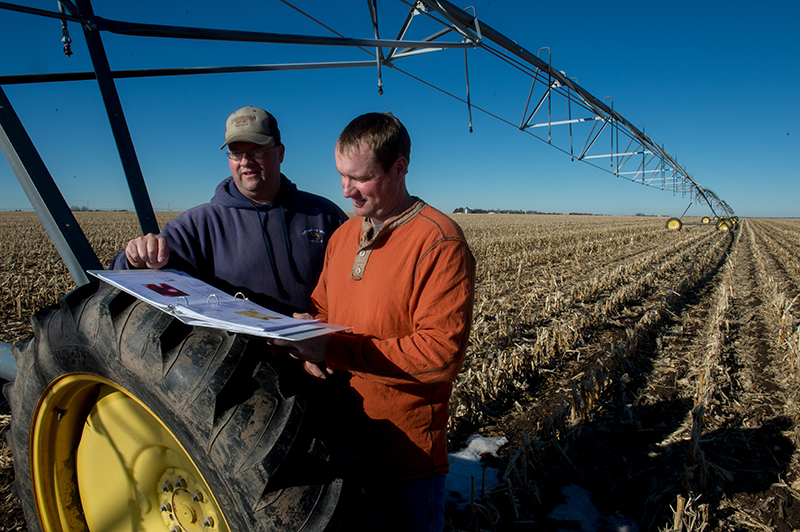Seed Variety Choices, Cold Tame Pests
While record-breaking low temperatures haven’t lasted as long this past winter (compared to 2013-14), extension experts believe they may affect a host of insect and disease problems. For insects, mortality may be higher. But for diseases that survive, then thrive, in the cool, wet soil left behind, growers should be concerned.
First, a look back. The one word multiple extension specialists used to describe insect activity in the Midwest last summer was “quiet.”
“I believe the very severe winter of 2013-14 and the heavy precipitation that followed, which led to saturated soils in the late spring, greatly lowered densities of western corn rootworm,” says Dr. Michael Gray, professor and assistant dean of the department of crop sciences at the University of Illinois. Overwintering eggs — especially those laid in the upper soil profile (2 to 4 inches) — likely suffered greater levels of overwintering mortality. And in general, larvae that hatch in saturated soils (say in late May and early June) do not survive very well.
Resistance concerns around Bt hybrids continue to loom large in many parts of the Midwest. In fact, in northeastern Illinois, rotation-resistant western corn rootworms have also developed resistance to the Cry3Bb1 and mCry3A proteins. He strongly encourages growers to continue rotating corn and soybeans; however, they should consider planting pyramided Bt hybrids in these areas, or use a planting-time soil insecticide with a non-Bt corn rootworm hybrid.
An important point: A planting time soil insecticide should not be needed with a pyramided Bt rootworm hybrid.

European Corn Borer
Dr. Christian Krupke, extension entomologist with Purdue University, also notes that crop rotation with non-corn is still the most effective way to keep Bt hybrids durable. This approach, combined with rotation of rootworm management techniques (such as don’t use the same Bt hybrid each time corn is planted), are the best ways to keep technologies as long as possible, he says.
Krupke recommends growers and dealers watch for fields with high levels of lodging/damage or adult corn rootworm beetles in early summer.
If he had to pinpoint a pest problem in Indiana it would be a few spotty corn borer infestations in non-Bt and seed corn. The problem was very isolated and hit a low proportion of the whole state, but it was an interesting reminder that this pest is still out there and that Bt hybrids targeting it continue to be strong performers, he says.
Unfortunately, Asiatic garden beetle continues to be a problem in corn following soybeans in several spots in northern Indiana counties with very sandy soils. High rates of seed treatment offer some control, but these larvae have proven tough to kill.
Soybeans had no reports of significant insect problems. In fact, it’s been several years since growers have had treatable levels of soybean aphids in large areas of Indiana.
In the mid-South, Andrea Phillips-Jones, research associate with the University of Missouri, was also surprised at milder than normal thrips pressure in cotton — and the sound performance of seed treatments.
However, tarnished plant bugs continue to be a huge problem. Control strategies include planting early (choosing varieties accordingly) and changing up chemistries. Phillips-Jones is encouraged that Mississippi State graduate work has shown promising data on the correlation of nitrogen management and plant bug activity. The pest is attracted to lush cotton, so managing vegetative growth is important.
“Consultants and researchers need to work together on growth management with plant growth regulators,” Phillips-Jones says. With the quick turnaround of cotton varieties, research on new varieties takes place only one year before commercial sales.
Fine Times For Disease
Also at the University of Missouri, Dr. Laura Sweets, extension associate professor, says growers saw “pretty spectacular” levels of sudden death syndrome (SDS) in 2014. The problem was widespread and severe across much of the state. She credits the wet spring, then cool, wet conditions that followed, especially as the crop was starting to flower.
Heading into 2015, Sweets says the intense winter cold coupled with a lack of snow cover in her state may bode well for disease mortality (snow cover can insulate and protect pathogens). Unfortunately, SDS inoculum can survive on soybean residue and actually move to corn residue and survive there. It also has structures that allow it to stay alive even in the absence much of residue, Sweets explains.
Crop rotation is a key management strategy for SDS, but new, improved variety resistance is now available as is a new seed treatment, Bayer’s ILeVO (fluopyram).
Daren Mueller, assistant professor at Iowa State University, notes that while many maturity groups have some levels of resistance to the disease, no soybeans are completely immune to SDS. Having an integrated management approach with the addition of ILeVO would provide a sound set of tools for growers to protect their crop when resistance breaks down, he feels. “We’ve tested it,” he says, “and it appears to be very effective in preventing damage from SDS.”
Mueller was also intrigued by another product, Syngenta’s Clariva Complete nematicide (active ingredient Pasteuria nishizawae), which has shown some promise for control of the ongoing problem of soybean cyst nematodes (SCN), according to research by Dr. Greg Tylka at Iowa State University.

Frogeye leaf spot on soybeans. Photo Credit: Daren Mueller, Iowa State University, Bugwood.org
Dr. Kiersten Wise, associate professor and extension specialist at Purdue University expressed concern about the growing number of strobilurin-tolerant strains of frogeye leaf spot on soybeans. Her team recommends farmers use fungicides in response to a disease threat and use products with mixed fungicide modes of action to delay shifts in fungicide sensitivity.
On corn, Missouri saw more Northern corn leaf blight in 2014, thanks again to cool, wet conditions. Then too, the university’s plant disease clinic fielded a lot of questions and samples of corn and soybeans with very slow germination and emergence because soil temperatures were so low — and stayed low for so long. The result: a lot of Pythium root rot, seed decay and seedling blight on corn and soybeans.
The situation was similar in the Midwest. Northern corn leaf blight also hit many other states, likely due to the cool, prolonged wet weather when the majority of the crop was silking and on through grain fill. Soybeans were hit with white mold and stem canker as well as SDS.
Disease outbreaks are always hard to predict, but Purdue’s Wise noticed that the wet fall limited Midwest tillage — so there may be more residue available this spring than usual.
The concern? “That residue harbors many of our pathogens (particularly corn) so this may influence disease levels in 2015,” she says.
Iowa’s Mueller summarized the soybean possibilities this way. Look for any disease that is more of a problem in extreme weather conditions: SDS and stem canker in a wet year; white mold and brown stem rot in a cool year; and SCN and charcoal rot in a
drier year.
Walk The Fields
Predictions aside, extension specialists do recommend the time-tested practice of scouting crops. Scouting and the use of economic thresholds has been greatly neglected and forgotten by many producers, especially large-scale commercial corn and soybean growers, says Illinois’ Gray.
“In light of tighter profit margins anticipated for 2015, producers should look at their pest input costs more closely than in many previous years,” he says. In fact, Gray feels the industry might see a small resurgence in scouting and use of economic thresholds this year.
He also encourages dealers themselves to pay more attention to scouting and thresholds and assure their customers that they are basing treatment decisions on these factors.
Some growers scout, but not many, Purdue’s Krupke has found. There is not too much incentive to do so for many of the pests, since Bt hybrids control many of them, and seed treatments are perceived to control most of the rest.
If there were one area where more scouting could or should be done, it is for early summer rootworm damage in Bt corn, in order to isolate potential problem fields where resistance has evolved, Krupke says.
There should be motivation to scout, says Iowa’s Mueller. For one thing, the technology is improving to track diseases, insects and weeds (consider the newest tablets, apps and UAVs, for instance). He says scouting data gathered is going to become more and more important — and useable — in crop modeling systems, precision zone management and precision planting.
Dr. Jeremy Greene, professor of entomology at Clemson University, says his best advice is for growers to hire a consultant. For the price of an insecticide application across their farm, they can have someone looking for problems. “Automatic applications will not pay off in the long run and very likely will not be a good solution in the short term either,” he says. “Why waste money or mis-time applications and not get the best bang for your buck?”





